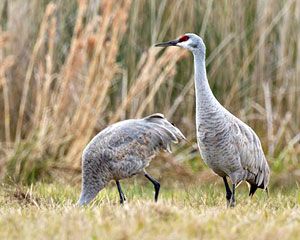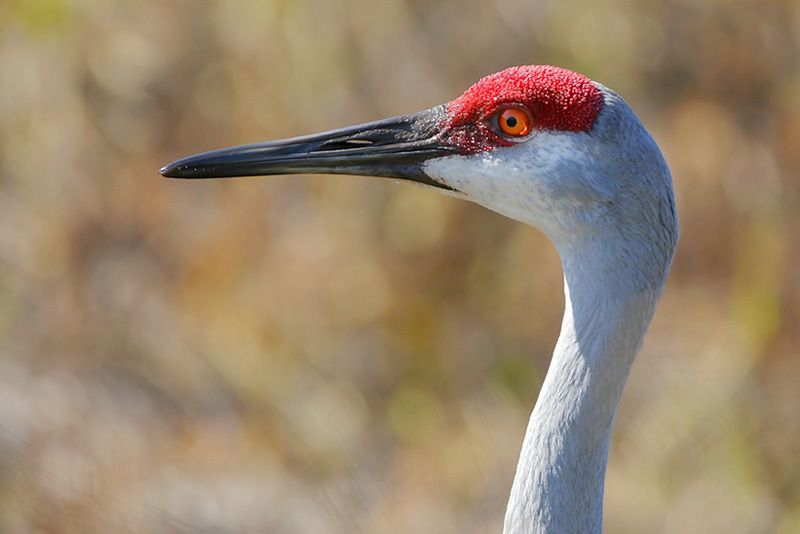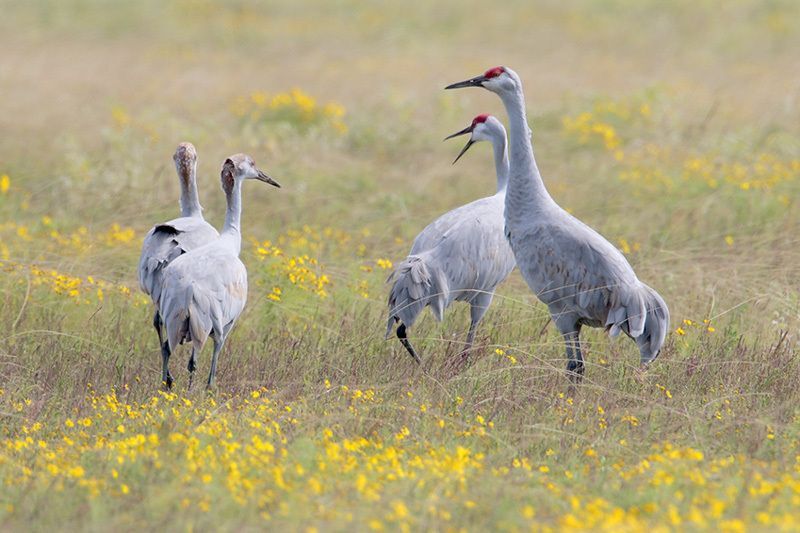Sandhill Crane

© Wayne Nicholas
Antigone canadensis
Family: (Gruidae) Cranes
Preferred Habitat: May be found in wet fields in rural areas around Houston. The fields close to Brazos Bend State Park and Attwater National Wildlife Refuge are two good areas to look.
Seasonal Occurrence: Uncommon November through March.
Profile by Glenn Olsen: What turned my eyes skyward was the loud but melodic and captivating calls that resonated in the clouds above. Often describe as bugling, but to my ears, it is more like a symphony of trumpeting horns and Swiss yodeling reverberating through alpine meadows from some fifties-era movie.
This harmonious calling of Sandhill Cranes in migration sent chills through me as the yodeling of a flock of Sandhill Cranes is to me one of the most stirring and beautiful sounds of any bird. This was the first flock and calls that I'd heard of the season as they migrated to the Upper Coast to spend the winter.
In flight the Sandhill Crane is easily distinguished from a Great Blue Heron (roughly similar in size and color) by the fact that cranes fly with neck fully extended and long legs trailing behind while the Great Blue Heron retracts its neck for long flights. The wing beat or flight pattern is also different, with the crane having a faster wing beat and the wings held flat and straight unlike the slightly cupped wings and slow, heavy wing beat of the Great Blue.
Gregarious by nature, we usually see small to large flocks feeding in fields, pastures, and coastal marshes. Adult birds are easily identified by the dull red crown, beret-like, on the lint-gray colored body with an odd-looking feather duster-shaped tail end. The feathers forming the duster are not the actual tail feathers but long tertial feathers that hang over the tail and are called a bustle. This structural feature alone is diagnostic on the three species of cranes that occur in the states.
We have the pleasure of seeing and hearing Sandhill Cranes during our winter months. Most of the Sandhills breed in Canada but some breed in various northern states. They leave their breeding grounds and begin arriving on the Upper Texas Coast in October, but the greatest numbers occur in December to February with a few lingering until the end of March. So a trip to any of our coastal marshes or a weedy field could yield a memorable experience with these winter residents. Join an Audubon field trip or register for the Holiday With The Cranes event in Galveston to improve your chances of an experience with these majestic birds.
Profile by Jon Piasecki: Sandhill Cranes are the smaller of the two species of crane native to North America. This species looks similar to their relative, the Whooping Crane, but are much more abundant. In fact, Sandhill Crane populations have been growing by nearly 4% each year since the 1960s. These birds are quite tall with long legs and necks. Sandhill Cranes are gray overall with some tan body feathering and a red crown. Immature birds lack the red crown but have the overall gray body with some tan coloring.
Sandhill Cranes breed throughout the northern half of the continent in places such as Alaska, most of Canada, and the northern part of the U.S. During the winter season, Sandhill Cranes can be found throughout parts of Texas, New Mexico, California, and the northern parts of Mexico. These birds are typically found in open, wet habitats with shrubs and trees. During migration and the nonbreeding season, Sandhill Cranes often group together in large flocks that can reach thousands strong. They tend to eat grains and seeds, but their diet can include a variety of items ranging from berries to small invertebrates.
Sandhill Cranes mate for life and will choose their mate by displaying. These behaviors can include leaping into the air, bowing, and outstretching their wings. After forming a pair or returning to the breeding grounds with their mate, cranes will build a nest in a wetland using surrounding vegetation such as cattails and grasses. Females will lay between 1-3 eggs that can take up to a full month to hatch. The family unit will stick together through fall migration and winter until the following spring when the juveniles depart on their own.
Sandhill Cranes have been seen all around the Houston area this winter (2022-23) including League City and Galveston. These birds will soon start heading on their way north for migration, so next time you are near an open field make sure to keep an eye out for large gray birds!
-
Cornell Lab of Ornithology
-
Field Guide
-
Bird Library

© Greg Lavaty, www.texastargetbirds.com

© Greg Lavaty, www.texastargetbirds.com

© Greg Lavaty, www.texastargetbirds.com

© Greg Lavaty, www.texastargetbirds.com

© Greg Lavaty, www.texastargetbirds.com




















